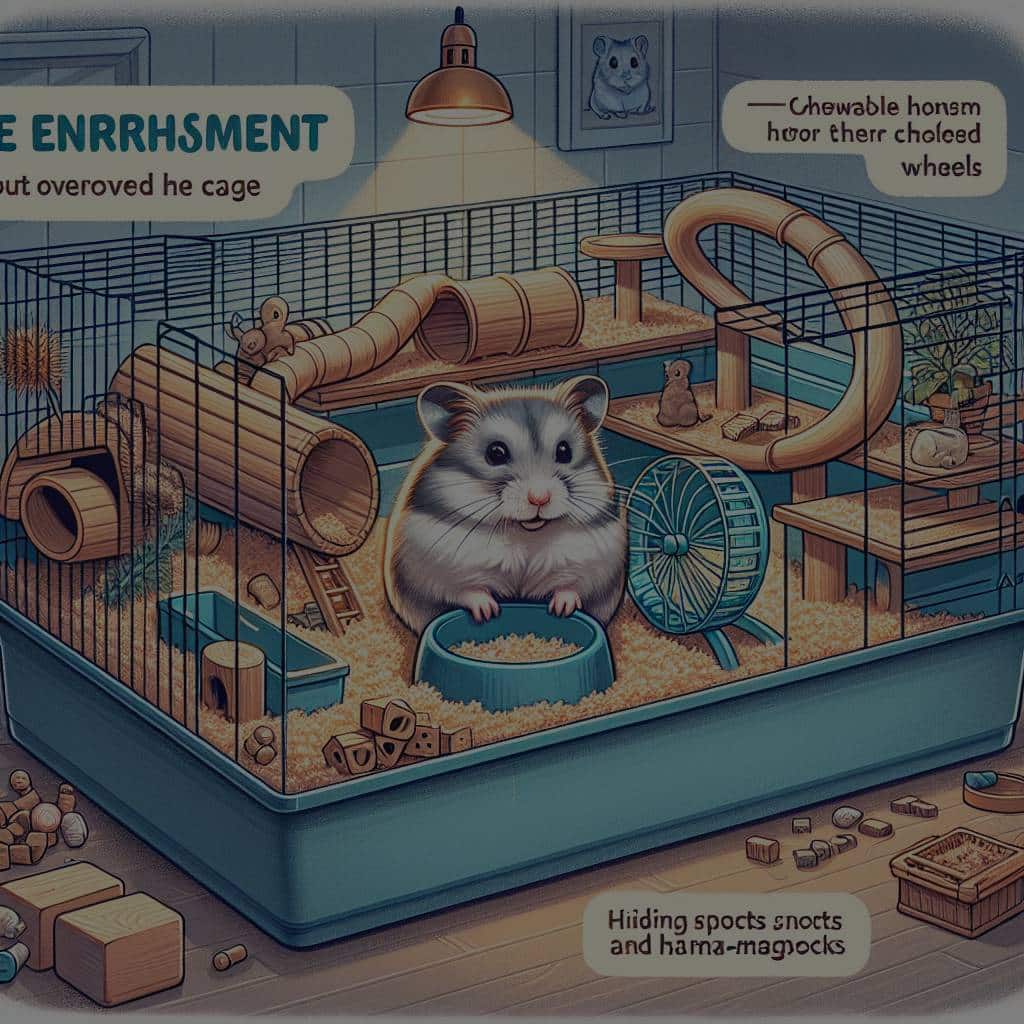How to Provide Enrichment for a Pet Hamster Without Overcrowding the Cage?

Providing enrichment for your pet hamster is a key component of good pet care. It keeps your pet stimulated, happy, and healthy. However, there’s a common concern among hamster owners: how can you provide enough enrichment without overcrowding their cage? From choosing the right cage to selecting the best toys and bedding, here’s a comprehensive guide on how to ensure your hamster has an enriched, yet uncluttered, living space.
1. Selecting the Perfect Cage: Space, Size, and Safety
An enclosure’s size is crucial for your hamster’s well-being. A cramped cage can lead to stress, which can notably impact a hamster’s health. Regardless of the size of your hamster, a generous living space is essential.
Also to discover : How to Train a Dog to Use a Designated Potty Area in a Yard?
However, it’s not just about size; the cage’s design plays a significant role as well. The design should accommodate your hamster’s natural behaviors, such as burrowing and climbing. Look for a cage with multiple levels and a deep bedding area.
Safety is another crucial factor to consider. Avoid cages with wire floors or sharp edges, which can harm your pet. Also, make sure the cage’s bars are close enough together to prevent your hamster from squeezing through.
This might interest you : What’s the Best Way to Prepare Your Dog for Therapy Work?
Finally, remember to keep the cage in a quiet, safe location, away from direct sunlight and draughts.
2. Choosing the Right Bedding, Sand, and Cleaning Routine
Your hamster’s bedding contributes significantly to their comfort and enrichment. Hamsters, like their wild counterparts, love to dig and burrow. Therefore, providing deep, clean bedding is essential. Opt for paper-based or aspen bedding, as some materials like cedar or pine shavings can be harmful to hamsters.
A sand bath is another enrichment hamster owners often overlook. Hamsters love rolling in sand to clean their coats and it also offers additional digging opportunities. Be sure to use sand safe for small pets, not dust or tiny particles that could cause respiratory problems.
As for cleaning, a regular routine is important to keep your pet’s home clean and odor-free. However, avoid overcleaning, as this can cause stress for your hamster. A full clean once a week, with spot cleaning for soiled areas every few days, should suffice.
3. Selecting Enriching Toys Without Overcrowding
Toys are essential for your hamster’s mental stimulation. However, it’s easy to go overboard and end up with a crowded cage. The trick is to choose high-value toys that offer multiple functions.
A wheel is a must-have for any hamster cage. It provides an avenue for your pet’s energy and keeps them fit. Ensure the wheel is solid (not wired) to prevent injuries, and large enough so your hamster’s back doesn’t arch when they run.
Tunnels and hideouts are also excellent choices, as they mimic the burrows hamsters would have in the wild. You can find multi-purpose toys that serve as both a hideout and a chew toy, saving you space.
4. Interaction and Out-of-Cage Time
Lastly, remember that enrichment isn’t confined to the cage. Hamsters are sociable animals and love to explore their surroundings. Daily interaction and supervised out-of-cage time are essential.
Consider investing in a hamster ball or create a safe playpen for your pet. While your hamster is out, you can clean their cage or rearrange their toys to keep their environment stimulating.
However, always ensure the play area is hamster-proof: remove any potential hazards, block off small spaces your pet might squeeze into, and keep other pets away.
5. Learning from Other Small Animals: Gerbils and Hamster Care
There’s a lot hamster owners can learn from looking at the care of other small pets, like gerbils. Gerbils are similar to hamsters in size and care needs, and they require the same amount of stimulation and space.
Gerbils are avid chewers, more so than hamsters. Thus, providing various chew toys can help keep your hamster’s teeth in check while providing enrichment.
Like hamsters, gerbils also appreciate a good sand bath, a solid exercise wheel, and plenty of bedding for burrowing. They also thrive with daily human interaction and exploration outside the enclosure.
However, remember that each pet is unique. What works for one may not work for another, so always observe your pet’s behavior and preferences. By understanding their needs and following these guidelines, you’ll be able to provide a stimulating environment for your pet hamster, without overcrowding their cage.
6. Dietary Enrichment for Hamsters
Dietary enrichment is an often overlooked aspect of pet care. Food isn’t just about nutrition, it’s also a source of stimulation and entertainment for small animals like hamsters.
As omnivores, hamsters have a diverse diet in the wild, including seeds, fruits, vegetables, and insects. Offering a variety of these in your hamster’s diet can provide enrichment and meet their nutritional needs.
You can also introduce puzzle feeders or hide food around the cage to stimulate your hamster’s natural foraging instincts. This not only keeps them active but mentally stimulated as well.
However, remember that not all human foods are safe for hamsters. Always do your research or consult a vet before introducing new foods. Also, ensure fresh food and water are readily available. A secure water bottle that attaches to the cage is a good investment to keep water clean and accessible.
7. A Comparison with Other Small Pets: Guinea Pigs and Hamster Care
Similar to gerbils and mice, guinea pigs can also provide useful insights into hamster care. Despite being larger, guinea pigs share a lot of characteristics with hamsters, gerbils, mice, and rats.
Guinea pigs thrive in a spacious cage with lots of tunnels and hiding spots. They are sociable animals and enjoy interaction with their human caregivers just like hamsters. Guinea pigs also require a diverse diet, which includes a variety of fruits, vegetables, and hay for mental stimulation and good health.
Also, like hamsters, guinea pigs need regular out-of-cage time in a safe, enclosed space. This allows them to explore, run around, and burn off energy.
However, as with gerbils, always remember that each small pet is unique. Guinea pigs, for instance, are more social than hamsters and may require a companion. Understanding your hamster’s individual needs and preferences is crucial in providing them with an enriching and healthy life.
Conclusion: Balancing Enrichment and Space for Your Pet Hamster
Providing a rich, stimulating environment for your pet hamster doesn’t mean you need to overcrowd their cage. By selecting a spacious cage, choosing multifunctional toys, providing the right bedding, sand, and a varied diet, you can offer your furry friend plenty of enrichment without compromising on space or their well-being.
Regular interaction and supervised out-of-cage time are also crucial components of hamster care. Remember that learning from other small animals, like gerbils, mice, and guinea pigs, can provide new insights and methods for improving your pet’s living conditions.
Lastly, always be observant of your hamster’s behavior as it is your best guide to understanding their unique needs and preferences. With the right understanding and approach, you can create an enriching, comfortable environment that promotes a happy, healthy life for your pet hamster.
